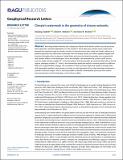Climate's watermark in the geometry of stream networks
Author(s)
Kirchner, James W.; Seybold, Hansjorg; Rothman, Daniel H.
DownloadRothman Seybold_et_al-2017-Geophysical_Research_Letters.pdf (21.20Mb)
PUBLISHER_POLICY
Publisher Policy
Article is made available in accordance with the publisher's policy and may be subject to US copyright law. Please refer to the publisher's site for terms of use.
Terms of use
Metadata
Show full item recordAbstract
Branching stream networks are a ubiquitous feature of the Earth's surface, but the processes that shape them, and their dependence on the climate in which they grow, remain poorly understood. Research has mainly focused on climatic controls of channel incision rates, while the climatic influence on planform geometry has often been overlooked. Here we analyze nearly one million digitally mapped river junctions throughout the contiguous United States and show that branching angles vary systematically with climatic aridity. In arid landscapes, which are thought to be dominated by surface runoff erosion, junction angles average roughly 45° in the driest places. Branching angles are systematically wider in humid regions, averaging roughly 72°, which is the theoretically predicted angle for network growth in a diffusive field such as groundwater seepage. The correlation of mean junction angle with aridity is stronger than with topographic gradient, downstream concavity, or other geometric factors that have been proposed as controls of junction angles. Thus, it may be possible to identify channelization processes from stream network geometry in relict landscapes, such as those on Mars. Keywords: stream networks; climatic controls; aridity
Date issued
2017-03Department
Massachusetts Institute of Technology. Department of Earth, Atmospheric, and Planetary Sciences; Lorenz Center (Massachusetts Institute of Technology)Journal
Geophysical Research Letters
Publisher
American Geophysical Union (AGU)
Citation
Seybold, Hansjörg et al. “Climate’s Watermark in the Geometry of Stream Networks.” Geophysical Research Letters 44, 5 (March 2017): 2272–2280 © 2017 American Geophysical Union
Version: Final published version
ISSN
0094-8276